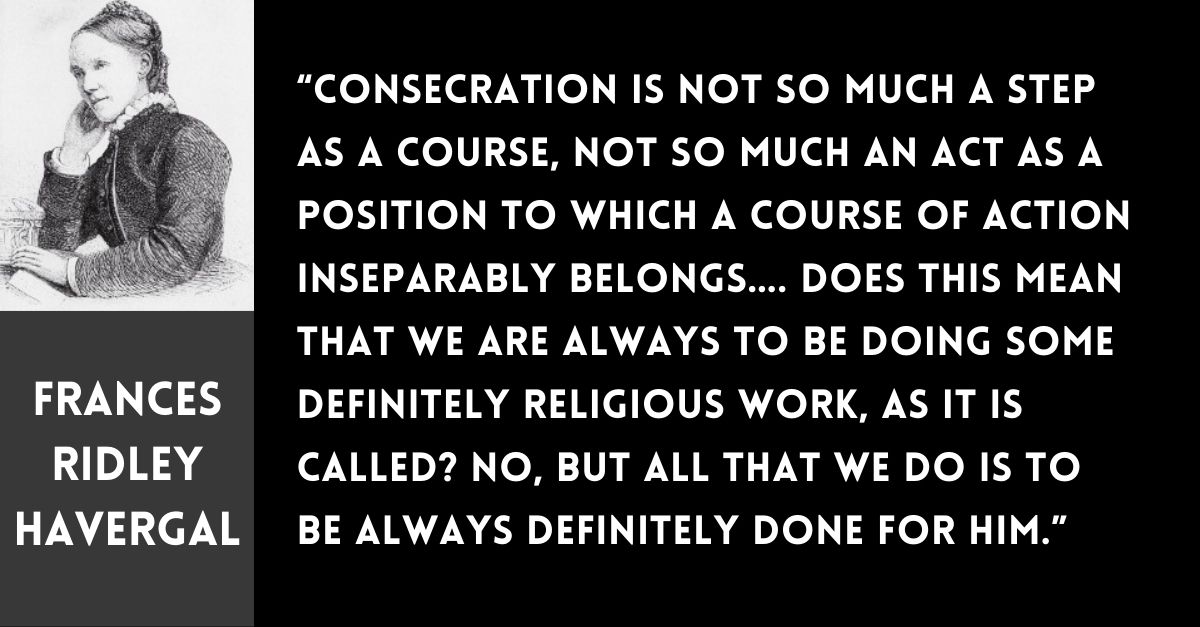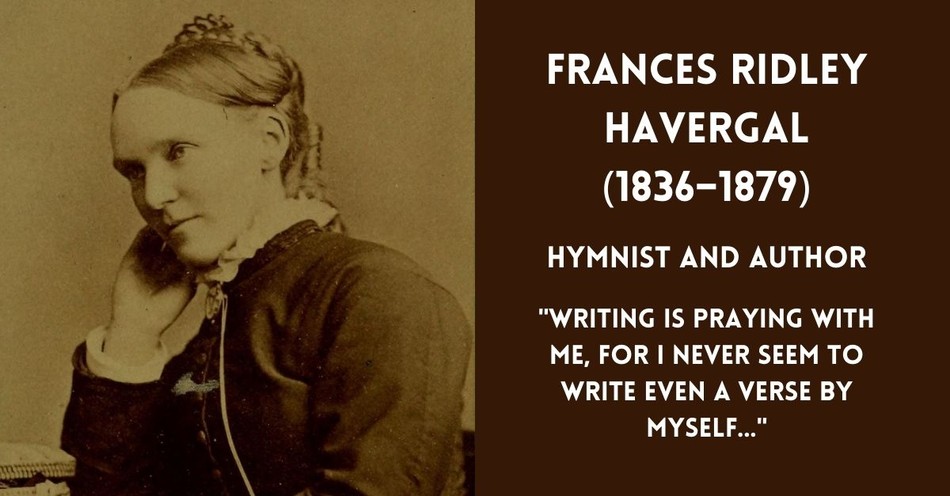Who Was Frances Havergal?
Frances Ridley Havergal was an English religious poet and hymn writer. She also wrote hymn melodies, religious tracts, and works for children. Havergal was born into an Anglican family, at Astley in Worcestershire. Her father, William Henry Havergal, was a clergyman, writer, composer, and hymn-writer. Her brother, Henry East Havergal, was a priest in the Church of England and an organist. In 1852 she studied in the Louisenschule, Düsseldorf, and at Oberkassel. Otherwise, she led a quiet life, not enjoying consistent good health; she traveled, in particular to Switzerland. She supported the Church Missionary Society.

'Take My Life and Let it Be'
"I went for a little visit of five days," wrote Frances Havergal, explaining what prompted her to write her well-known hymn, "Take My Life and Let it Be."
"There were ten persons in the house; some were unconverted and long prayed for, some converted but not rejoicing Christians. [God] gave me the prayer, 'Lord, give me all in this house.' And He just did. Before I left the house, everyone had got a blessing. The last night of my visit I was too happy to sleep and passed most of the night in renewal of my consecration, and those little couplets formed themselves and chimed in my heart one after another till they finished with "ever only, ALL FOR THEE!"
It was on this day, February 4, l874, that Frances wrote the hymn that is still sung around the world.
Havergal's Christian Influence
One of the most dedicated Christian women of the nineteenth century, Frances was the youngest child of a Church of England minister. Though she was always in frail health, she led an active life, encouraging many people to turn to Jesus and others to seek a deeper spiritual walk.
Frances had begun reading and memorizing the Bible at the age of four (eventually memorizing The Psalms, Isaiah and most of the New Testament). At seven she wrote her first poems. Several of her mature verses became hymns. In addition to "Take My Life," she wrote such favorites as "I Gave My Life for Thee," "Like a River Glorious," and "Who Is on the Lord's Side?"
Because her voice was lovely, Frances was in demand as a concert soloist. She also was a brilliant pianist and learned several modern languages as well as Greek and Hebrew. With all her education, however, Frances Havergal maintained a simple faith and confidence in her Lord. She never wrote a line of poetry without praying over it.
One of the lines of Frances Havergal's hymn says, "Take my silver and my gold; not a mite would I withhold." In 1878, four years after writing the hymn, Miss Havergal wrote a friend, The Lord has shown me another little step, and, of course, I have taken it with extreme delight. 'Take my silver and my gold' now means shipping off all my ornaments to the Church Missionary House, including a jewel cabinet that is really fit for a countess, where all will be accepted and disposed of for me...Nearly fifty articles are being packed up. I don't think I ever packed a box with such pleasure."
'Take My Life and Let it Be'
Take my life and let it be
Consecrated, Lord, to Thee.
Take my moments and my days,
Let them flow in endless praise.
Take my hands and let them move
At the impulse of Thy love.
Take my feet and let them be
Swift and beautiful for Thee.
Take my voice and let me sing,
Always, only for my King.
Take my lips and let them be
Filled with messages from Thee.
Take my silver and my gold,
Not a mite would I withhold.
Take my intellect and use
Every pow’r as Thou shalt choose.
Take my will and make it Thine,
It shall be no longer mine.
Take my heart, it is Thine own,
It shall be Thy royal throne.
Take my love, my Lord, I pour
At Thy feet its treasure store.
Take myself and I will be
Ever, only, all for Thee.
Bibliography:
1. Adapted from an earlier Christian History Institute story.
2. "Frances Ridley Havergal (1836-1879)." http://www.cyberhymnal.org
3. "Havergal, Frances Ridley." The Oxford Dictionary of the Christian Church, edited by F. L. Cross and E. A. Livingstone. Oxford, 1997.
4. Wells, Amos R. A Treasure of Hymns; Brief biographies of 120 leading hymn- writers and Their best hymns. Boston: W. A. Wilde company, 1945.
5. Various internet articles.
Article first published on Christianity.com on April 28, 2010.
Photo Credit: ©Public domain photo from 1886 book, via Wikimedia Commons
This article is part of our People of Christianity catalog that features the stories, meaning, and significance of well-known people from the Bible and history. Here are some of the most popular articles for knowing important figures in Christianity:
How Did the Apostle Paul Die?
Who are the Nicolaitans in Revelation?
Who Was Deborah in the Bible?
Who Was Moses in the Bible?
King Solomon's Story in the Bible
Who Was Lot's Wife in the Bible?
Who Was Jezebel in the Bible?
Who Was the Prodigal Son?








